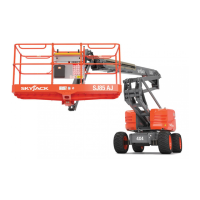213217AAA SJ85 AJ
30
Section 3 – Familiarization Features and Devices
FAMILIARIZATION
3.4-2 Drive speed
The drive speed depends upon the machine
conguration (lowered travel position/elevated travel
position). When the MEWP is in the elevated travel
position, the maximum achievable drive speed should
be signicantly less than the lowered travel position
drive speed. Refer to Section 7.4.
3.4-3 Drive direction
The drive function operates in accordance with the
general orientation of the turret’s counterweight over
the chassis (i.e. joystick forward means counterweight
is facing forward). Therefore, the MEWP will move in
the general direction of the joystick’s movement.
3.4-4 Tilt switch
The tilt switch is located within the base control
console. When the MEWP is on a slope greater than
a predetermined limit, an audible alarm sounds, a
visual indicator illuminates, and boom movement or
drive functions are disabled (refer to Section 3.4-5).
WARNING
When tilt settings are exceeded, causing the alarm
to sound and the light to illuminate, the platform
should be lowered and retracted immediately.
Refer to Section 6.2 for instructions on how to
recover from an inclined position.
NOTE
Resetting power to the controls (e.g. e-stop
depressed then pulled out) when the MEWP
is tilted and at the limits of the lowered travel
position will cause the MEWP to be considered
tilted while elevated.
3.4-5 Function restrictions when tilted
Mode/Condition
Indicator
Light
Audible
Alarm
Restrictions
Emergency Power
(Platform)
Emergency Power
(Base)
Lowered travel position, tilted Disabled Disabled No restriction Enabled Enabled
In lowered travel position, tilted,
moving into elevated travel
position (at the limits of the lowered
travel position)
Enabled Enabled
Boom Extension,
Boom Up, and
Riser Up disabled
Enabled Enabled
Elevated travel position Enabled Enabled Drive disabled Enabled Enabled
1254AC
3.4-6 Platform load sensing system
The platform capacity is determined by boom
position (boom extension and boom angle). Each
boom position zone (high capacity zone or low
capacity zone) has a separate capacity. Refer to
platform capacity label(s) for maximum platform
capacity of each zone.
The platform load sensing system indicates when the
load is approaching overload status (refer to
Section 3.4-7).
If the platform is overloaded while in elevated travel
position, the load sensing system will disable
functions as per Section 3.4-7, and signal the
operator with an indicator light and an audible alarm.
If the platform is overloaded while in lowered travel
position, the load sensing system will signal the
operator with an indicator light and an audible alarm
but will not disable any functions (refer to
Section 3.4-7).
WARNING
If the platform is overloaded due to contact with an
overhead obstruction, do one of the following:
▪
Remove the obstruction from the platform,
then after a four-second delay normal
functions can be resumed.
▪
Use the emergency power unit to release the
platform from the obstruction.
▪
Do not attempt to free a snagged platform
with lower controls until personnel are
removed from the platform.

